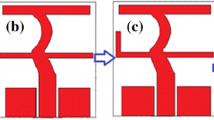Abstract
In this letter, a dual-band dipole antenna, both in the strip and the wired structures, for possible 4G long-term evolution (LTE) and wireless local area network (WLAN) applications is presented. The proposed antenna bandwidth covers the low and the high bands of WLAN (2.4 GHz, 5 GHz) and TD-LTE (1880–2655 MHz) in dual-band frequency, the impedance bandwidth in the low and the high bands are 63% (1.6–3.1 GHz) and 15% (4.75–5.55 GHz) respectively. The omnidirectional radiation patterns are desirable for WLAN and LTE communications. The maximum gains of 6.23 dBi and 5.13 dBi in both WLAN bands are adequate for stable gain applications. To avoiding the dissemination of the outer surface of the coaxial cable a copper cylinder is employed as a balun. Simple structure, use of printed circuit technology and FR4 material in the construction of the proposed antenna make it economical and easily-fabricated. The proposed antenna is also designed with the wired structure for similar purposes. Finally, the strip prototype of the antenna is implemented. Experimental results along with the simulation results have validated the merits of the proposed antenna involving simple and inexpensive structure, simultaneously covering WLAN and LTE frequency bands and almost high and stable gain in both bands.






Similar content being viewed by others
References
Li, Y., Jiang, T., & Mittra, R. (2016). A miniaturized dual-band antenna with toothbrush-shaped patch and meander line for WLAN applications. Wireless Personal Communications, 91(2), 595–602.
Peng, L., & Ruan, C. L. (2011). A microstrip fed patch antenna with two parasitic invert L stubs for dual-band WLAN applications. Wireless Personal Communications, 57(4), 727–734.
Sharma, S. K., Abdalla, M. A., & Chaudhary, R. K. (2017). An electrically small sicrr metamaterial-inspired dual-band antenna for WLAN and WiMAX applications. Microwave and Optical Technology Letters, 59(3), 573–578.
Taghvaee, H., Habibi, A., Rezaee, A., & Zarinkhat, F. (2017). Low profile UHF loop antenna prototyped and investigated by circuit modeling. Microwave and Optical Technology Letters, 59(2), 459–463.
Qu, L., Zhang, R., Kim, H. H., & Kim, H. (2015). Compact dual-band antenna using inverted-L loop and inner rectangular loop for WLAN applications. Electronics Letters, 51(23), 1843–1844.
Deepak, U., Roshna, T. K., Nijas, C. M., Vasudevan, K., & Mohanan, P. (2015). A dual band SIR coupled dipole antenna for 2.4/5.2/5.8 GHz applications. IEEE Transactions on Antennas and Propagation, 63(4), 1514–1520.
Wu, J., Zhao, Z., Nie, Z., & Liu, Q. H. (2015). A printed unidirectional antenna with improved upper band-edge selectivity using a parasitic loop. IEEE Transactions on Antennas and Propagation, 63(4), 1832–1837.
Lee, H., Cheong, S., & Kim, Y. C. (2014). Design of a half-ring type dipole antenna for WLAN communications. Microwave and Optical Technology Letters, 56(8), 1832–1836.
Boopathi Rani, R., & Pandey, S. K. (2017). ELC metamaterial based CPW-fed printed dual-band antenna. Microwave and Optical Technology Letters, 59(2), 304–307.
Park, J. S., Choi, H. K., & Oh, J. H. (2016). The design of a dual band omnidirectional horizontally polarized antenna with arc-shaped lines and overlapping lines. Microwave and Optical Technology Letters, 58(5), 1117–1121.
Chien, H. Y., & Lee, C. H. (2013). Dual-/triple-band asymmetric dipole antenna for WLAN operation in laptop computer. IEEE Transactions on Antennas and Propagation, 61(7), 3808–3813.
Chen, S., Dong, D., Liao, Z., Cai, Q., & Liu, G. (2014). Compact wideband and dual-band antenna for TD-LTE and WLAN applications. Electronics Letters, 50(16), 1111–1112.
Kim, O. S. (2014). Rapid prototyping of electrically small spherical wire antennas. IEEE Transactions on Antennas and Propagation, 62(7), 3839–3842.
Balanis Constantine, A. (2016). Antenna theory analysis and design. New York: Wiley.
Author information
Authors and Affiliations
Corresponding author
Additional information
Publisher's Note
Springer Nature remains neutral with regard to jurisdictional claims in published maps and institutional affiliations.
Rights and permissions
About this article
Cite this article
Amin, E., Ghalamkari, B. & Naser-Moghadasi, M. A Novel Dual-Band Dipole Antenna for WLAN and LTE Applications. Wireless Pers Commun 108, 2675–2683 (2019). https://doi.org/10.1007/s11277-019-06545-1
Published:
Issue Date:
DOI: https://doi.org/10.1007/s11277-019-06545-1




